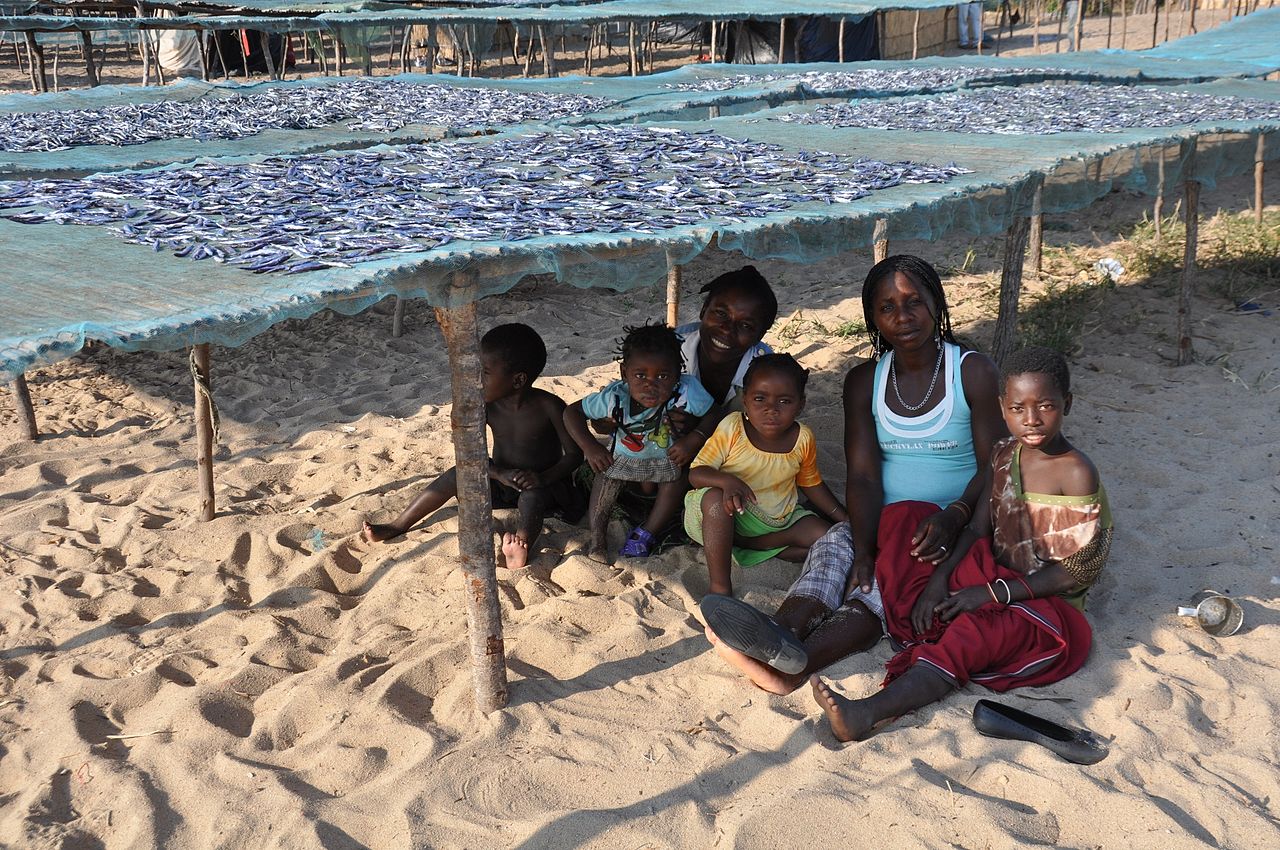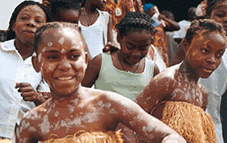Bonjour, welcome to Equatorial Guinea, the tropical country on the Gulf of Guinea!

Location
Equatorial Guinea consists of two parts, a small mainland and several islands. It is situated in central Africa, it shares its border with Cameroon and Gabon. To the west it has a coastal strip on the Gulf of Guinea. On the map above you can see that the largest island Bioko is not on the coast in front of the country but much further north, in front of the coast of Cameroon.

Malabo, the capital of Equatorial Guinea is on this island. The southernmost part of the country consists of the island Annobón, it lies in front of the coast of Gabon, only 156 kilometers south of the Equator.
Landscape

Equatorial Guinea is a tropical country with long coastal lines, primal rain forests, and a diverse animal kingdom. The islands are covered in rain forests. On the mainland thick jungles grow with trees that are thousands of years old. The coasts are covered in mangrove woods. Since the country is in the tropical climate zone it rains almost year-round.
What the Flag Tells about Equatorial Guinea
 The flag of Equatorial Guinea is a tricolor; the emblem is a mangrove tree. The color red on the flag stands for the blood that was spilt during the populations fight for independence. The white stripe in the middle stands for peace. The green stripe is symbolic for the rain forests and the fertile nature.
The flag of Equatorial Guinea is a tricolor; the emblem is a mangrove tree. The color red on the flag stands for the blood that was spilt during the populations fight for independence. The white stripe in the middle stands for peace. The green stripe is symbolic for the rain forests and the fertile nature.
Malabo, the Capital
The capital of Equatorial Guinea is not on the mainland but on the largest island named Bioko. Bioko is situated between an impressive volcanic chain and blue ocean. The city was built after a Spanish role model and many of the houses are a reminder of the Spanish colonial era.

A very impressive building in Malabo is the Presidential Palace on the Plaza de España, which was built in a gothic style. The cathedral of the capital of Equatorial Guinea is breathtakingly beautiful as well. The colorful market of Malabo and the port are definitely worth a visit. In front of the island there are many oil refineries.
Peoples and Languages
 A third of the population lives on the island Bioko, the rest live on the mainland. The Fang constitute the biggest demographic group in Equatorial Guinea. They still tend to their age-old traditions and worship their ancestors and Gods. For most of the natives Fang is a mother tongue. The official languages are Spanish, Portuguese, and French. Why? Equatorial Guinea used to be a Spanish colony. Why are there three official languages in such a small country? The government wanted to trade with all former colonial powers. Another legacy of the Spanish colonial era is religion. Almost all Equatorial Guineans are of a roman-catholic belief. The Fang and Bubi still celebrate their old ceremonies and rituals on the side though. Women and men who possess magic skills are idolized in the community.
A third of the population lives on the island Bioko, the rest live on the mainland. The Fang constitute the biggest demographic group in Equatorial Guinea. They still tend to their age-old traditions and worship their ancestors and Gods. For most of the natives Fang is a mother tongue. The official languages are Spanish, Portuguese, and French. Why? Equatorial Guinea used to be a Spanish colony. Why are there three official languages in such a small country? The government wanted to trade with all former colonial powers. Another legacy of the Spanish colonial era is religion. Almost all Equatorial Guineans are of a roman-catholic belief. The Fang and Bubi still celebrate their old ceremonies and rituals on the side though. Women and men who possess magic skills are idolized in the community.
Celebrations and Festivities
 One of the most important ceremonies, which is held since primeval times, is named “Abira”. Special dances and songs are used to free society of all evil. The Balele Dance is probably the most famous one. The dancers are accompanied by drums, balafons, and harps and citters.
One of the most important ceremonies, which is held since primeval times, is named “Abira”. Special dances and songs are used to free society of all evil. The Balele Dance is probably the most famous one. The dancers are accompanied by drums, balafons, and harps and citters.
School and Education
 The public school system is still at an early stage in Equatorial Guinea. Most schools in the country are supported by church missions and Spanish institutions. School is generally mandatory but only a part of the families can pay the school fees. School books and material are a great financial burden as well. This is why often only boys visit secondary schools. The literacy rate is the highest in southern Africa though. More than 90% of inhabitants can read and write. There are not enough well-trained employees though. A university opened in Malabo a few years ago but only children from rich families have the means to attend.
The public school system is still at an early stage in Equatorial Guinea. Most schools in the country are supported by church missions and Spanish institutions. School is generally mandatory but only a part of the families can pay the school fees. School books and material are a great financial burden as well. This is why often only boys visit secondary schools. The literacy rate is the highest in southern Africa though. More than 90% of inhabitants can read and write. There are not enough well-trained employees though. A university opened in Malabo a few years ago but only children from rich families have the means to attend.
What Children Play in Malabo
Favorites are swimming competitions and of course street soccer; since all children can play soccer. All you need is a ball, which the children quickly make using plastic bags, bits of cloth, and ropes or threads. The girls enjoy soccer as well, even though their mothers do not like this. Equatorial Guinea does have a strong women’s soccer team though! Girls play other games as well of course. For example, they play a type of volleyball and like to dance.
Animal Kingdom

There are still primall rain forests, where chimps and gorillas, who have become quite rare, live. Equatorial Guinea is one of the few countries where you can still watch these primates in their natural habitat. The petite forest elephants, who live in the Monte Alén National Park, are quite impressive as well. The forest elephants are smaller than their relatives from the savannah. They have created star-shaped trails on which they always travel to their meeting points. You can observe crocodiles, antelopes, and many other inhabitants of the savannah in this park. There are many colorful and exotic birds and insects to discover also.
Economy and Natural Resources

Most Equatorial Guineans live off of agriculture. Since crude oil was found in Equatorial Guinea the extraction of this “black gold” has become the main source of income for the country. Especially the coastal regions have rich oil reserves. Despite the country being so small, it is the third largest oil producer in southern Africa. Many people work in the oil industry but they do not earn very well. More than half of the population here lives on less than one US-Dollar a day. It rains a lot here but half the population does not have access to clean water. Most don’t even have functioning toilets.
Attractions

History
 The original inhabitants of Equatorial Guinea were probably Pygmies, indigenous forest people, that roamed the rain forests for millennia. In the course of the first migration of the peoples around 800 AD, Bantu peoples exiled the Pygmies. Their descendants are the Fang, who still constitute a majority of the inhabitants. Around 1500 the Portuguese colonized Equatorial Guinea. Portugal controlled the country for more than 200 years until they yielded their power to the Spanish. This is how the small country became Spain’s only colony in southern Africa. Spain built the city Malobo on the island Bioko and created a plantation economy.
The original inhabitants of Equatorial Guinea were probably Pygmies, indigenous forest people, that roamed the rain forests for millennia. In the course of the first migration of the peoples around 800 AD, Bantu peoples exiled the Pygmies. Their descendants are the Fang, who still constitute a majority of the inhabitants. Around 1500 the Portuguese colonized Equatorial Guinea. Portugal controlled the country for more than 200 years until they yielded their power to the Spanish. This is how the small country became Spain’s only colony in southern Africa. Spain built the city Malobo on the island Bioko and created a plantation economy.
Equatorial Guinea Today

The country gained independence from Spain on October 12th, 1968. The first African president did not rule in favor of his people. On the contrary. He acted the way former Spanish colonialists would have. The inhabitants were mad and wanted him removed. He was overthrown in 1979. His successor did not rule with such an authoritarian style but he does not allow free press and human rights are not fully respected. Equatorial Guinea is one of the richest countries in Africa, but only a few people benefit from the oil riches. What do the children in Equatorial Guinea wish for? They want their parents to receive fair wages. School might be possible for everyone then. They would also want clean water. It’s hard to believe but only half of the population has access to clean, running water!







